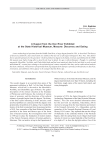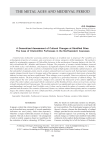Archaeology, Ethnology & Anthropology of Eurasia @journal-aeae-en
Статьи журнала - Archaeology, Ethnology & Anthropology of Eurasia
Все статьи: 524

A case of systemic connective tissue disorder in a Pazyryk male from the Altai Mountains
Статья научная
We present the results of an anthropological and paleopathological study of a male skeleton from a Pazyryk kurgan 1 burial 1 at Ak-Alakha-1, the Altai Mountains. The archaeological context testifi es to a rather high social status of this person. His appearance was modeled using a modern facial reconstruction method. The combination of craniometric and anthropometric traits indicates a brachycranic Caucasoid type, which predominated in the male population of the Volga-Ural region and Western Kazakhstan in 600–200 BC. The individual suffered from a systemic disorder of the connective tissue affecting virtually all parts of the skeleton. The case is unique, and the condition is diagnosed as DISH—diffuse idiopathic skeletal hyperostosis, possibly caused by grave metabolic and endocrine disorders. Judging by his physical type, the male was not native to the Altai Mountains and belonged to a population that was not genetically adapted to that region. This may account for the severity of the rheumatoid disorder, which was aggravated by 4th degree osteoporosis of lumbar vertebrae and pelvic bones and by traumatic lesions of the shoulder girdle.
Бесплатно

A chalcolithic burial in the mountain-forest zone of the Trans-Urals
Статья научная
We describe an unusual burial at a stratifi ed Chalcolithic site Shaitanskoye 4-6 on the coast of the eponymous lake in the Sverdlovsk Region. An individual, aged 18–35 was buried in an oval fl at-grave pit, 1.6 × 0.56 × 0.2 m in size. We give a detailed description of sixty funerary items, made of stone: three unusually large knives manufactured on thin chert plates (the nearest outcrops are found in Northern Kazakhstan and Southern Urals); a projectile head, 19 arrowheads, 18 fl int bladelets from a side-bladed tool, a polished axe-adze, a composite tool on a blade, two plates with use-wear traces, and 15 beads. Notably, some of the artifacts are made of “southern” rocks. The results of the isotope analysis indicate considerable mobility and close ties between populations of the forest and steppe Trans- Urals in the 4th and 3d millennia BC. The Chalcolithic site, which, apart from the burial, includes habitation deposits with numerous artifacts such as ceramics of various types, lithics including a large series of arrowheads and several fl int fi gurines, can be viewed as a complex archaeological object where, among other activities, rites were performed securing group consolidation.
Бесплатно

Статья научная
This article examines the key cultural trends and events in the evolution of the Upper Paleolithic in the foothills of the Northern Tien Shan (Zailisky Alatau, Kazakhstan). It outlines the history of Paleolithic studies in southeastern Kazakhstan. We describe the geographic characteristics of the region, the geomorphological positions of sites, and features of sedimentation that infl uenced the preservation of cultural remains in situ. Archaeological materials from key Upper Paleolithic sites are reviewed, including those from stratifi ed sites—Maibulak, Rakhat, and Uzynagash-1, -2. Lithic industries and absolute dates suggest that Maibulak was permanently inhabited during the Early, Middle, and probably Late Upper Paleolithic, materials from the early stages being the most expressive. Early Upper Paleolithic industries display Aurignacian-like characteristics and are paralleled by certain Western Eurasian industries of the same age. The multicomponent site of Rakhat was peopled during the end of the Early Upper Paleolithic, in the Middle Upper Paleolithic, and at the beginning of the Late Upper Paleolithic, documenting the evolution of Upper Paleolithic cultures during the ~30–23 cal ka BP interval. The industries of Rakhat include an Aurignacianlike one, a Middle Upper Paleolithic complex with micro-Gravette-like points, and one with geometric artifacts shaped as scalene triangles. For the fi rst time, results of excavations and prospects of future studies at the new sites Uzynagash-1 and -2, dating to the late Early Upper Paleolithic, are outlined. We conclude that Upper Paleolithic cultures (or industries) of the foothills of the Northern Tien Shan are original, while following a single vector with the Upper Paleolithic of Western Eurasia.
Бесплатно

A digital X-ray analysis of Middle Bronze Age skeletal samples from the Baraba forest-steppe
Статья
We present the results of a comparative analysis of skeletal and dental pathologies in Middle Bronze Age individuals buried at Late Krotovo and Andronovo (Fedorovka) cemeteries in southwestern Siberia. This was the period when the Andronovo steppe tradition in Northern and Central Asia expanded in various directions, including the foreststeppe. Growth arrest lines on tibiae (Harris lines) and dental pathologies (enamel hypoplasia and caries) were recorded. To evaluate developmental anomalies in the bone tissue, digital X-ray analysis was used. The principal sample includes representatives of various sex and age groups buried at the largest cemetery in the region, Tartas-1 (Baraba forest-steppe). Harris lines and enamel hypoplasia result from a broad range of factors such as infections, occasional malnutrition, traumas, vitamin defi ciencies, etc. Caries is caused by a high amount of carbohydrates in the diet, accompanied by low standards of oral hygiene. These pathologies occur at different ages: Harris lines and enamel hypoplasia evidence adverse factors during infancy and adolescence, whereas caries is typical of adulthood. Late Krotovo and Andronovo groups differ in terms of occurrence and combination of pathologies. Enamel hypoplasia is less frequent in the Andronovo sample, indicating a lesser stress level in children. Harris lines are less frequent in the Late Krotovo group, suggestive of lower stress level during adolescence. These differences may be tentatively attributed to various models of subsistence and cultural adaptation.
Бесплатно

A dugout from the Don river exhibited at the State historical museum, Moscow: discovery and dating
Статья
Бесплатно

A functional analysis of lithics of the Early Iron Age Yankovsky culture: new findings
Статья научная
We present the results of a functional analysis of lithics of the Yankovsky culture (800 BC to the turn of the millennium) from two sites–Cherepakha-7 and Solontsovaya-2, excavated over large areas during salvage works in 2015 and 2017, respectively. Such tools are traditionally described as axes, adzes, chisels, knives, spearheads, and projectile points. Certain findings of the functional analysis disagree with this classification. The question arises of the correspondence between formal typological and traceological criteria. For functional analysis, the so-called Keeley method, or High Power Approach, was used, along with the classification of polishing types, elaborated at Tohoku University (Japan). Functions of 28 of the 62 tools selected for high-precision functional analysis were assessed. The existing nomenclature of woodworking tool types is clarified, information on the technique of harvesting herbaceous plants and on leatherworking tools is significantly specified. More details are provided on tools involved in bone carving, as well as those used to open shells of bivalve mollusks. The High Power Approach has enhanced our understanding of the functions of stone tools, which, despite the use of metals, were basic in Yankovsky technologies. Further directions of traceological studies are suggested.
Бесплатно

A half of a metal bipartite mold of the Seima-Turbino period from the Upper Irtysh region
Статья обзорная
Бесплатно

A house model from Popudnya, Cucuteni-Tripolye culture, Ukraine: a new interpretation
Статья
Бесплатно

A late 16th to early 17th century Mongolian ceremonial helmet from the Moscow Kremlin Armoury
Статья обзорная
Бесплатно

A log structure in the northern palisade of Fort Umrevinsky
Статья научная
The study describes the findings of excavations at the northern palisade of Fort Umrevinsky. We revealed the basis of a log structure with a floor made of planks, adjoining the central part of the northern palisade. A tight joining of the palisade ditch with the two preserved rows of logs indicates a single construction episode. At this area, another entrance to the territory of the fort was revealed, situated right opposite the southern one. Design features of the foundation of the log structure (the way of cutting logs, the floor made of planks), dimensions (6 × 6 m), and location suggest that this was the base of the northern passage tower. Spatial structure, location, and size of the structure match those of wooden towers of Siberian forts. During earlier studies at one of the corner towers of Fort Umrevinsky, built as early as the second quarter of the 18th century, a plank floor was also revealed. The northern passage tower was erected at the initial stage (before the first third of the 18th century) of the fort's existence. This wooden defensive structure suggests that Fort Umrevinsky was one of border fortifications, each of which had a sub-rectangular palisade and a single entrance tower. The foundation of the northern entrance tower was probably described in 1741 by J.G. Gmelin as a ruin of a guardhouse. Towers of Siberian forts were multifunctional. Apart from their defensive function, they served as guardhouses and were also destined for living and storage.
Бесплатно

A medieval Yakut burial near lake Atlasovskoye of the 14th–15th centuries: an anthropological study
Статья научная
The burial near Lake Atlasovskoye, Yakutia, is one of the earliest Yakut burials, dating back to the 14th or 15th centuries and associated with the medieval Kulun-Atakh culture. Initially, its age was assessed by the comparative typological method based on artifacts, and later а radiocarbon estimate was generated, suggesting that the burial dates to the early stage of the Kulun-Atakh culture. Its highly unusual feature is that the individual was buried in a seated position – an exceptional case in the Yakut funerary practice. The cranium was completely wrapped in a bandage sewn from birchbark sheets, under which lethal injuries were found. Our comprehensive study was aimed at assessing the individual's lifestyle and cause of death. Postcranial bones revealed pathologal symptoms unusual for an early age (20–25) and caused by excessive physical strain, suggesting that the man was either a slave or a warrior. The complex birchbark bandage may indicate high status. Together with the seated position of the body, this makes the military status even more likely. Multiple traumatic lesions infl icted with a cutting tool indicate the violent nature of confl icts at the early stage of the Yakut culture. Craniometruic analysis reveals Buryat and Mongol affi nities, supporting epic evidence relating to Yakut origins, in which Buryat or Mongol immigrants had taken part.
Бесплатно










